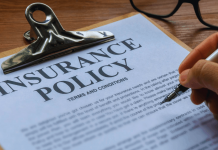Many people don’t take the time to read the details in their home insurance policies.
As a result, they’re often surprised by what’s not covered when they file a claim.
This article explains what’s included, what’s excluded, and how to understand the fine print.
What Standard Home Insurance Policies Cover
Knowing what’s covered helps you avoid surprises during a claim. Here’s what most standard home insurance policies include:
- Dwelling Protection: Covers your home’s structure—walls, roof, and built-ins—from fire, hail, and similar events.
- Other Structures: Includes detached buildings like garages, fences, and sheds (usually up to 10% of dwelling coverage).
- Personal Property: Covers items like furniture, clothes, and electronics, even if stolen outside the home.
- Liability Protection: Pays if someone gets hurt on your property or if you cause damage to others.
- Medical Payments: Covers small medical bills for injured guests, regardless of who’s at fault.
- Loss of Use: Pays for hotels and meals if your home is unlivable after a covered event.

What’s Often Not Covered (Exclusions)
Not everything is protected by a standard policy. These common exclusions can leave you with unexpected costs:
- Floods and Earthquakes: Not included in basic policies; you need separate coverage for these disasters.
- Wear and Tear: Damage from aging, mold, pests, or neglect isn’t covered.
- High-Value Items: Jewelry, art, and collectibles may have low coverage limits unless extra coverage is added.
- Business Use: Items or damage related to running a business from home are usually excluded.
- Intentional Damage: Losses caused on purpose by the homeowner or covered residents won’t be paid.
- Government Action: Damage due to seizure or demolition by order of a government body isn’t covered.
Important Policy Terms You Need to Understand
Understanding these terms helps you know how much you’ll receive in a claim. Here are key definitions found in most home insurance policies:
- Actual Cash Value (ACV): Pays the current value of damaged items, factoring in depreciation.
- Replacement Cost: Pays the full cost to replace items with new ones, without deducting for age.
- Deductible: The amount you pay out of pocket before insurance covers the rest.
- Coverage Limit: The maximum amount your insurer will pay for a specific type of loss.
- Named Perils: A list of events covered explicitly by your policy, like fire or theft.
- All-Risk (Open Perils): Covers everything except what’s specifically excluded in the policy.
- Endorsement (Rider): Add-on that expands or customizes your coverage for specific needs.
How to Read and Understand the Fine Print
Reading the fine print helps you avoid confusion and denied claims. Focus on these key parts of your policy:
- Declarations Page: Gives a summary of your coverage, limits, and deductibles—start here first.
- Exclusions Section: Lists what’s not covered, which is critical to know before disaster strikes.
- Conditions Section: Explains what you must do to keep coverage valid, like prompt reporting.
- Definitions Section: Clarifies terms used throughout the policy to avoid misunderstandings.
- Endorsements: Shows added coverage or changes to your base policy—these can affect payouts.
- Claim Requirements: Tells you what proof or documents are needed when filing a claim.
When and How to Review or Update Your Policy
Reviewing your policy regularly ensures your coverage stays accurate and valuable. Here are key times and ways to update it:
- After Renovations: Update coverage if you remodel or add value to your home.
- After Big Purchases: Add riders for expensive items like jewelry, electronics, or art.
- Once a Year: Do an annual review to adjust for inflation or lifestyle changes.
- After Life Events: Marriage, divorce, or a new baby may change your coverage needs.
- Check for New Discounts: Ask your insurer if you’re eligible for loyalty, alarm system, or bundle discounts.
- Talk to Your Agent: Schedule a quick check-in to go over your current needs and policy details.

How Claims Are Handled Step-by-Step
Understanding how the claims process works can save you time and reduce stress. Follow these steps to handle a home insurance claim effectively:
- Report the Damage Immediately: Contact your insurer right away and share when, how, and what was damaged.
- Document Everything: Take clear photos or videos of the damage. Save receipts, serial numbers, or any proof of ownership.
- File the Claim Form: Complete your insurer’s official claim form online or by phone. Include all required documents to avoid delays.
- Meet the Adjuster (If Required): An insurance adjuster may visit to assess the damage. Answer their questions and show them the affected areas.
- Review the Settlement Offer: Your insurer will provide a payout offer based on your coverage. Make sure it aligns with your policy terms.
- Accept or Appeal the Offer: If the offer seems fair, accept it and start repairs. If not, gather more proof and request a review or appeal.
What to Know About Policy Renewals
Home insurance renewals can include changes you might miss if you’re not careful. Always review them closely to stay fully protected.
- Read Renewal Notices: Check for updates in coverage, limits, or premium amounts.
- Compare With Your Old Policy: Look for changes in exclusions, deductible amounts, or added conditions.
- Watch for Rate Increases: Premiums can rise even without a claim—understand why before renewing.
- Use It as a Review Opportunity: Update your policy if you’ve renovated, bought new items, or changed your living situation.
- Contact Your Insurer With Questions: Ask about anything unclear or request changes that better match your needs.
Differences Between Insurance Providers
Not all insurance companies offer the same coverage, service, or pricing. Comparing providers helps you choose one that better fits your needs.
- Policy Clarity: Some insurers use simpler, easier-to-read policy language than others.
- Coverage Options: Available add-ons and customizations can vary widely between companies.
- Customer Service: Claim support, response time, and ease of communication can differ.
- Premium Costs: Prices for similar coverage may vary depending on risk factors and discounts.
- Claim Handling Speed: Some companies process claims faster and with fewer delays than others.
Why a Home Inventory Matters
A home inventory helps you get faster, more accurate payouts after a loss. It also prevents disputes during the claims process.
- Tracks What You Own: Lists your belongings so you don’t forget items when filing a claim.
- Supports Claim Accuracy: Speeds up claims by providing proof of ownership and value.
- Helps Set Coverage Limits: Ensures your policy has enough coverage for all your items.
- Useful for Theft or Fire Losses: Provides clear records if items are destroyed or stolen.
- Easy to Create With Apps: Use inventory tools to record details, photos, and receipts in one place.
Conclusion: Know What You’re Paying For
Understanding the details in your home insurance policy helps you avoid surprises when it matters most.
Knowing what’s covered, what’s excluded, and how to handle claims puts you in control.
Take a few minutes today to review your policy and ask your insurer questions if anything is unclear.










